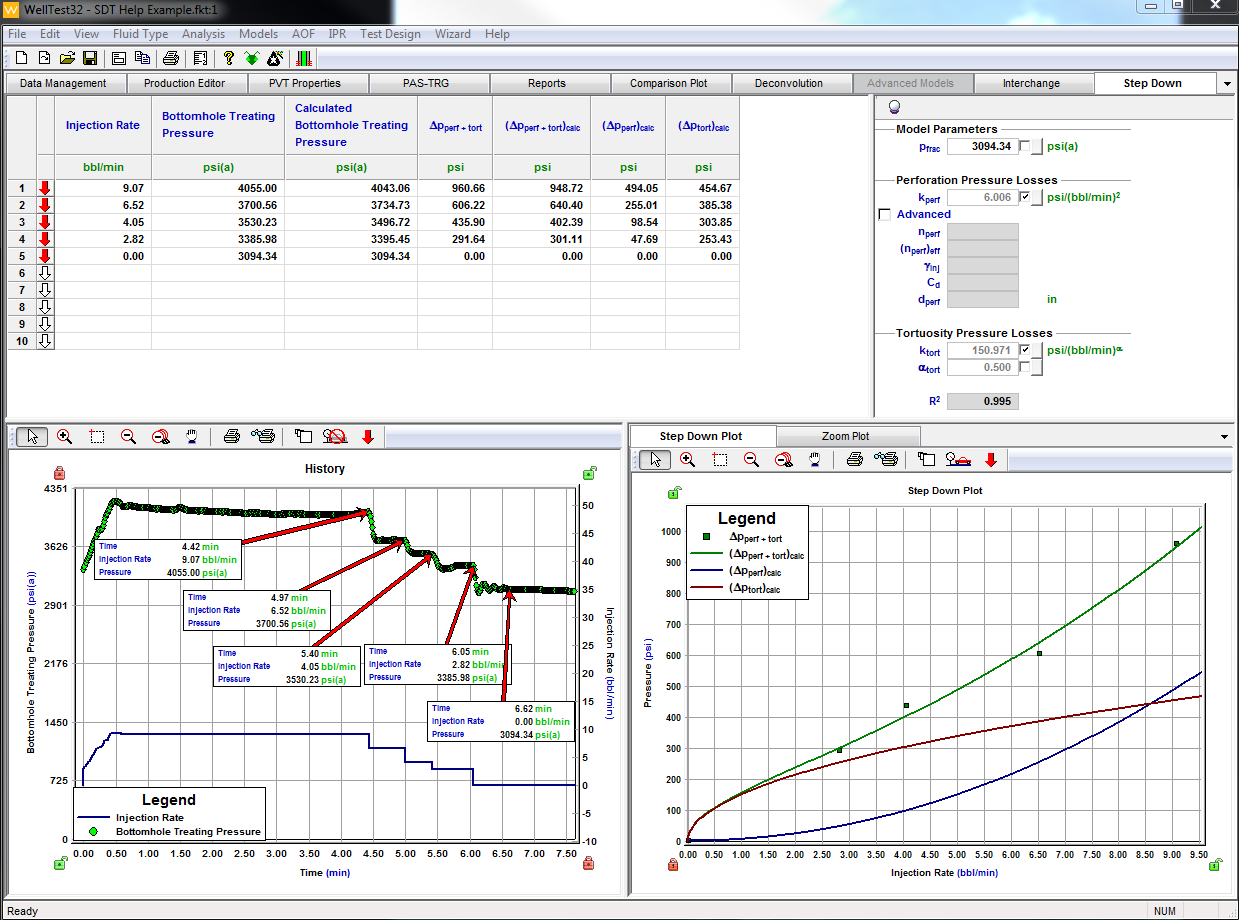Step Down Test Analysis
This type of analysis is performed prior to a main frac job. It is used to quantify perforation and near-wellbore pressure losses (caused by tortuosity) of frac'd wells, and as a result, provides information pertinent to the design and execution of the main frac treatments. Step-down tests can be performed during the shut-down sequence of a fracture calibration test.
To perform this test, a fluid of known properties (for example, water) is injected into the formation at a rate high enough to initiate a small frac. The injection rate is then reduced in a stair-step fashion, each rate lasting an equal time interval, before the well is finally shut-in. The resulting pressure response caused by the rate changes is influenced by perforation and near-wellbore friction. Tortuosity and perforation friction pressure losses vary differently with rate. By analyzing the pressure losses experienced at different rates, we can differentiate between pressure losses due to tortuosity and due to perforation friction.
Pressure drops across perforations and due to tortuosity are given mathematically by the following equations:
where
| Δp perf | Perforation pressure loss, psi |
| Δp tort | Tortuosity pressure loss, psi |
| q | Flow rate, stb / d |
| k perf | Perforation pressure loss coefficient, psi / ( stb / d )2 |
| k tort | Tortuosity pressure loss coefficient, psi / ( stb / d )2 |
| γ inj | Specific gravity of injected fluid |
| C d | Discharge coefficient |
| n perf | Number of perforations |
| d perf | Diameter of perforation, in |
| α | Tortuosity pressure loss exponent, usually 0.5 |
For step-down tests, it is essential to keep as many variables controlled as possible, so that the pressure response during the rate changes is due largely to perforations and tortuosity, and not some other factors. It is recommended to maintain relatively short periods for each injection rate, so that the frac remains substantially the same for each injection period. Short injection periods also help prevent the frac from closing prematurely before the test is complete. When the injection rate is changed, the pressure does not change in a stair-step fashion; it takes some time for pressure to stabilize after a change in rate. To make sure the effect of this pressure transition does not obscure the relationship between the injection rate and pressure, injection periods of the same duration are used.
Step-down test analysis is done by plotting the pressure / rate data points with the same time since the last rate change on a pressure-rate plot, and matching the pressure loss model (given by the equations above) to these points. On the basis of the model, the perforation and tortuosity components of the pressure loss are calculated, and the defining parameters are also estimated.
The step-down test analysis module in WellTest is as shown in the figure below. The module comprises four sections. The bottom-left section houses the history plot. The top-left section contains the data grid where the user inputs data points to use in the analysis. Data points can be entered either manually in the grid, or by using the “Point Selection” arrow to pick desired points in the history plot. The top-right section is where you enter initial estimates of the parameters used in the pressure loss model. The pressure fracture (pfrac) parameter initial estimate should be set to the instantaneous shut-in pressure (ISIP). The bottom-right section serves two purposes, depending on the active tab; the Zoom tab is used to fine-tune point selection, while the Step Down Plot tab displays the analysis results graphically.
